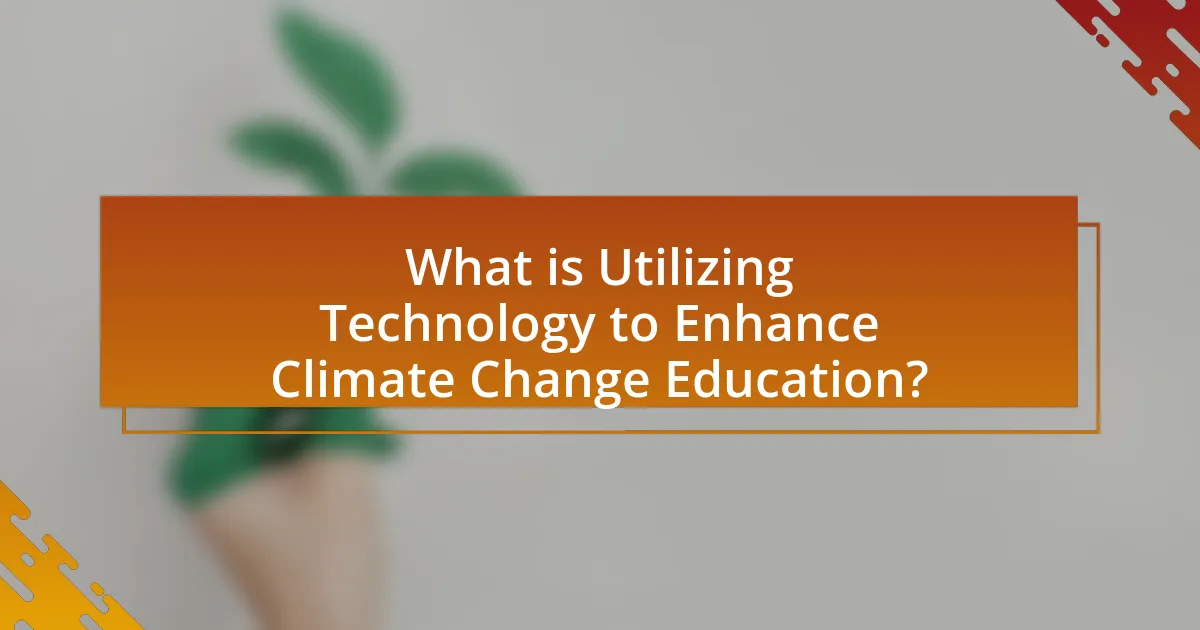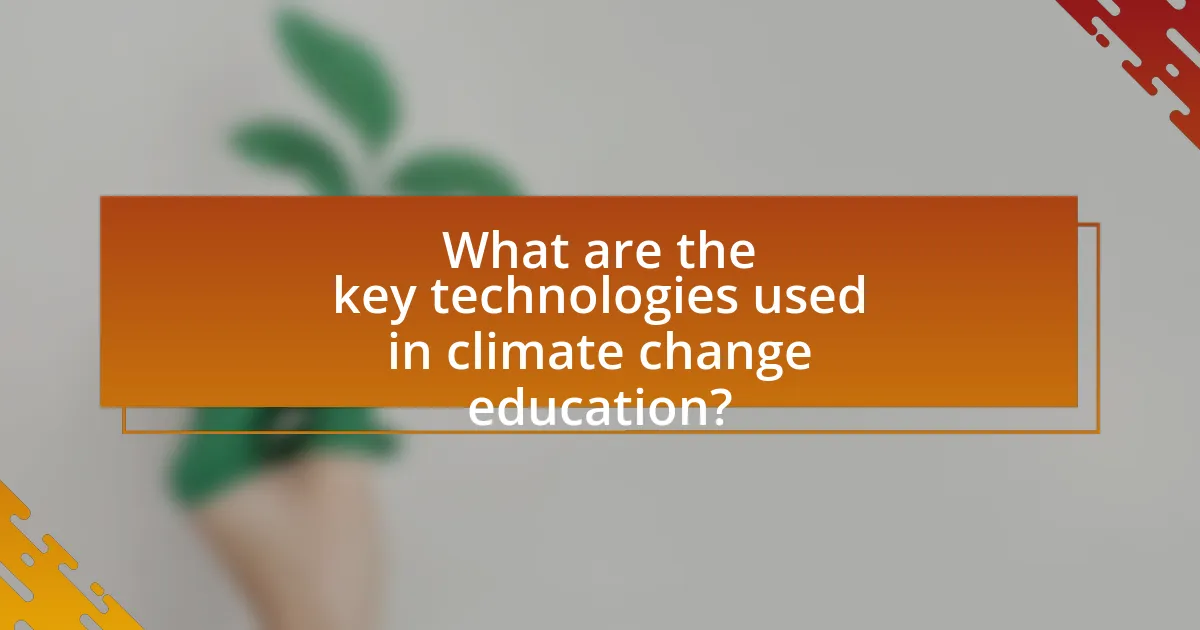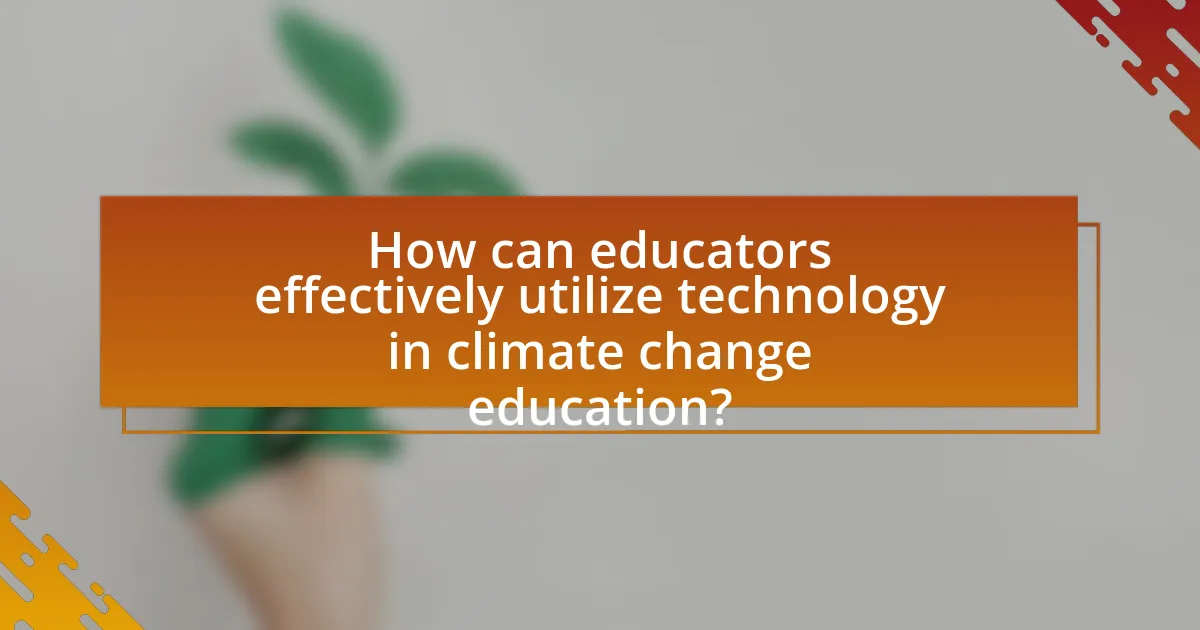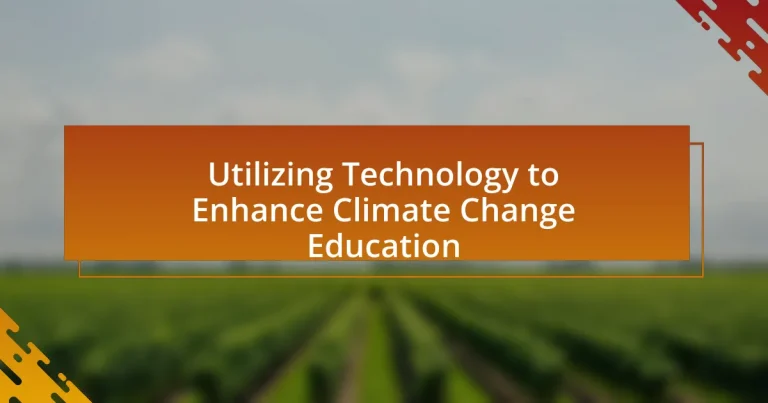Utilizing technology to enhance climate change education involves the integration of digital tools and platforms to improve understanding and awareness of climate issues. This article explores various methods of incorporating technology, such as online courses, interactive simulations, and virtual reality experiences, which have been shown to significantly increase knowledge retention and engagement among learners. Key technologies discussed include MOOCs, data visualization tools, and mobile applications, all of which facilitate interactive learning and improve accessibility to climate information. Additionally, the article addresses the importance of technology in fostering inclusivity and enhancing the effectiveness of climate change education, while also highlighting best practices and future trends in this evolving field.

What is Utilizing Technology to Enhance Climate Change Education?
Utilizing technology to enhance climate change education involves integrating digital tools and platforms to improve understanding and awareness of climate issues. This approach includes using online courses, interactive simulations, and virtual reality experiences to engage learners effectively. For instance, studies have shown that interactive learning environments can increase knowledge retention by up to 75%, compared to traditional methods. Additionally, platforms like MOOCs (Massive Open Online Courses) provide access to climate education for a global audience, breaking geographical barriers and promoting inclusivity.
How can technology be integrated into climate change education?
Technology can be integrated into climate change education through interactive platforms, virtual simulations, and data visualization tools. These technologies enable students to engage with climate data in real-time, fostering a deeper understanding of climate systems and their impacts. For instance, platforms like NASA’s Eyes on the Earth allow users to visualize climate change data, while simulations can demonstrate the effects of various environmental policies. Research indicates that interactive learning environments significantly enhance student engagement and retention of complex subjects, making technology a vital component in effectively teaching climate change.
What types of technology are most effective for climate change education?
Interactive digital platforms, such as online courses and educational apps, are among the most effective technologies for climate change education. These platforms facilitate engaging learning experiences through multimedia content, simulations, and interactive quizzes, which enhance understanding and retention of complex climate concepts. For instance, platforms like Coursera and edX offer courses developed by universities that cover climate science and sustainability, reaching millions of learners globally. Additionally, virtual reality (VR) and augmented reality (AR) technologies provide immersive experiences that allow users to visualize the impacts of climate change, making the learning process more impactful. Research indicates that immersive learning environments can significantly improve knowledge retention and engagement, as evidenced by studies showing that students using VR for environmental education demonstrate higher levels of understanding compared to traditional methods.
How does technology facilitate interactive learning about climate change?
Technology facilitates interactive learning about climate change by providing immersive experiences and real-time data analysis. Tools such as virtual reality simulations allow learners to visualize climate scenarios, while platforms like interactive maps and data dashboards enable users to explore climate data dynamically. For instance, the use of online simulations can demonstrate the impact of carbon emissions on global temperatures, making abstract concepts tangible. Additionally, educational apps and online courses often incorporate gamification elements, which enhance engagement and retention of information. Research indicates that interactive learning environments significantly improve understanding and motivation, as evidenced by a study published in the Journal of Environmental Education, which found that students exposed to interactive technology showed a 30% increase in knowledge retention compared to traditional methods.
Why is technology important in climate change education?
Technology is important in climate change education because it enhances accessibility, engagement, and the dissemination of information. Digital platforms allow for the widespread sharing of knowledge, enabling learners from diverse backgrounds to access resources and participate in discussions about climate change. For instance, interactive simulations and virtual reality experiences can illustrate complex climate models, making the information more relatable and easier to understand. Additionally, data analytics tools can help educators track student progress and tailor learning experiences to individual needs, thereby improving educational outcomes. According to a report by the United Nations Educational, Scientific and Cultural Organization (UNESCO), integrating technology in education can significantly increase student engagement and retention of information, which is crucial for fostering a deeper understanding of climate change issues.
What role does technology play in increasing awareness of climate issues?
Technology plays a crucial role in increasing awareness of climate issues by facilitating the dissemination of information and enabling real-time data analysis. Digital platforms, such as social media and websites, allow for the rapid sharing of climate-related news, research, and educational content, reaching a global audience. For instance, the use of satellite technology provides accurate data on climate change indicators, such as deforestation rates and greenhouse gas emissions, which can be visualized and shared to enhance public understanding. Additionally, interactive tools like climate modeling software and mobile applications engage users by allowing them to explore the impacts of climate change in their local areas, thereby fostering a personal connection to the issue. These technological advancements not only inform but also empower individuals and communities to take action against climate change.
How does technology improve accessibility to climate change information?
Technology improves accessibility to climate change information by providing diverse platforms for dissemination and engagement. Digital tools such as websites, mobile applications, and social media enable real-time sharing of data and resources, making information readily available to a global audience. For instance, the use of interactive maps and data visualization tools allows users to understand complex climate data intuitively. According to a report by the United Nations Environment Programme, over 4 billion people now have internet access, significantly increasing the reach of climate-related information. Additionally, technology facilitates the creation of online courses and webinars, allowing individuals to learn about climate change from experts regardless of their geographical location. This democratization of information empowers communities to engage in climate action effectively.

What are the key technologies used in climate change education?
Key technologies used in climate change education include online learning platforms, interactive simulations, and data visualization tools. Online learning platforms, such as Coursera and edX, provide access to courses on climate science and sustainability, enabling learners worldwide to engage with the material. Interactive simulations, like those offered by Climate Interactive, allow users to model climate scenarios and understand the impact of various factors on climate change. Data visualization tools, such as Tableau and Google Earth, help present complex climate data in an accessible format, making it easier for educators and students to analyze trends and draw conclusions. These technologies enhance engagement and understanding, facilitating a more informed public discourse on climate issues.
How do online platforms enhance climate change learning?
Online platforms enhance climate change learning by providing accessible, diverse, and interactive educational resources. These platforms offer a wide range of materials, including videos, articles, and interactive simulations, which cater to different learning styles and preferences. For instance, platforms like Coursera and edX host courses from reputable universities, allowing learners to engage with expert content and participate in discussions. Additionally, online forums and social media facilitate collaboration and knowledge sharing among users, fostering a community of learners dedicated to climate change education. Research indicates that interactive learning experiences significantly improve retention and understanding, making online platforms effective tools for climate change education.
What features make online platforms effective for climate change education?
Online platforms are effective for climate change education due to their accessibility, interactivity, and ability to provide up-to-date information. Accessibility allows learners from diverse backgrounds to engage with educational content anytime and anywhere, which is crucial given the global nature of climate change. Interactivity, through quizzes, forums, and multimedia resources, enhances engagement and retention of information, making learning more impactful. Furthermore, online platforms can quickly disseminate the latest research and data, ensuring that users have access to current and relevant information, which is vital for understanding the evolving nature of climate science. These features collectively contribute to a more informed and proactive public regarding climate change issues.
How can social media be leveraged for climate change awareness?
Social media can be leveraged for climate change awareness by facilitating the rapid dissemination of information and engaging diverse audiences. Platforms like Twitter, Facebook, and Instagram allow organizations and individuals to share educational content, real-time updates on climate events, and personal stories that resonate emotionally with users. For example, campaigns such as #FridaysForFuture have mobilized millions globally, demonstrating the power of social media in organizing climate strikes and raising awareness about climate issues. Additionally, studies show that visual content, such as infographics and videos, significantly increases engagement and information retention, making social media an effective tool for educating the public about climate change impacts and solutions.
What role do mobile applications play in climate change education?
Mobile applications play a crucial role in climate change education by providing accessible platforms for information dissemination and engagement. These applications facilitate real-time data sharing, interactive learning experiences, and community involvement, which enhance users’ understanding of climate issues. For instance, apps like “Earth Challenge” allow users to contribute to citizen science by reporting environmental data, thereby fostering a sense of responsibility and action towards climate change. Additionally, research indicates that mobile learning can increase knowledge retention and engagement, making it an effective tool for educating diverse audiences about climate change impacts and solutions.
What are some popular mobile apps focused on climate change education?
Some popular mobile apps focused on climate change education include “Earth Hero,” “Kahoot!,” and “Climate Change: The Facts.” Earth Hero provides users with actionable steps to reduce their carbon footprint and learn about climate issues. Kahoot! offers interactive quizzes and games that educate users on climate science and sustainability. Climate Change: The Facts presents information from experts and allows users to explore the impacts of climate change. These apps are widely recognized for their educational content and user engagement, making them effective tools for raising awareness about climate change.
How do mobile apps engage users in climate action?
Mobile apps engage users in climate action by providing interactive platforms that facilitate awareness, education, and community involvement. These applications often feature gamification elements, allowing users to track their carbon footprint, participate in challenges, and earn rewards for sustainable behaviors. For instance, apps like “JouleBug” and “Oroeco” encourage users to adopt eco-friendly habits by making the process engaging and social, thereby increasing user participation. Research indicates that gamified approaches can enhance user motivation and commitment to climate action, as evidenced by a study published in the journal “Environmental Science & Policy,” which found that users of gamified apps reported a 30% increase in sustainable practices.

How can educators effectively utilize technology in climate change education?
Educators can effectively utilize technology in climate change education by integrating interactive digital tools, such as simulations and online platforms, to enhance student engagement and understanding. For instance, using virtual reality (VR) can immerse students in climate scenarios, allowing them to experience the impacts of climate change firsthand, which has been shown to increase empathy and awareness. Additionally, online resources like data visualization tools enable students to analyze real-time climate data, fostering critical thinking skills. Research indicates that technology-enhanced learning environments can improve knowledge retention and motivation, as evidenced by a study published in the Journal of Environmental Education Research, which found that students exposed to technology-driven lessons demonstrated a 30% increase in climate literacy compared to traditional methods.
What strategies can educators adopt to integrate technology into their curriculum?
Educators can adopt strategies such as incorporating interactive simulations, utilizing online collaborative tools, and integrating multimedia resources to effectively integrate technology into their curriculum. Interactive simulations, like those provided by platforms such as PhET, allow students to visualize complex climate change concepts in a hands-on manner. Online collaborative tools, such as Google Workspace, enable students to work together on projects in real-time, fostering teamwork and communication skills. Additionally, integrating multimedia resources, including videos and podcasts, can enhance engagement and provide diverse perspectives on climate change topics. These strategies have been shown to improve student understanding and retention of information, as evidenced by studies indicating that technology-enhanced learning environments lead to higher academic performance.
How can educators assess the effectiveness of technology in teaching climate change?
Educators can assess the effectiveness of technology in teaching climate change by measuring student engagement, understanding, and retention of information through various metrics. For instance, they can utilize pre- and post-assessments to evaluate knowledge gains, analyze participation rates in technology-based activities, and gather student feedback on their learning experiences. Research indicates that technology-enhanced learning environments can lead to improved student outcomes; a study by the U.S. Department of Education found that students using technology for learning showed a 20% increase in achievement compared to traditional methods. Additionally, educators can track the application of learned concepts in real-world scenarios, which further demonstrates the impact of technology on students’ comprehension of climate change issues.
What challenges might educators face when using technology for climate change education?
Educators may face several challenges when using technology for climate change education, including access to resources, varying levels of digital literacy among students, and the need for accurate and up-to-date information. Limited access to technology can hinder students’ ability to engage with educational materials, particularly in underfunded schools or rural areas. Additionally, educators must navigate the diverse digital skills of their students, as some may struggle with technology, impacting their learning experience. Furthermore, the rapidly evolving nature of climate science necessitates that educators continuously seek reliable sources to ensure that the information they provide is current and scientifically valid.
What best practices should educators follow when using technology in climate change education?
Educators should prioritize interactive and engaging technology tools to enhance climate change education. Utilizing platforms like simulations, virtual reality, and interactive data visualization can help students grasp complex climate concepts effectively. Research indicates that interactive learning environments significantly improve student engagement and retention of information, as evidenced by a study published in the Journal of Educational Psychology, which found that students in interactive settings scored 20% higher on assessments related to climate science compared to traditional lecture-based approaches. Additionally, integrating real-time data from sources like NASA or NOAA allows students to analyze current climate trends, fostering critical thinking and problem-solving skills. By adopting these best practices, educators can create a more impactful and relevant learning experience in climate change education.
How can educators ensure that technology is used inclusively in climate change education?
Educators can ensure that technology is used inclusively in climate change education by implementing adaptive learning technologies that cater to diverse learning needs. These technologies can provide personalized learning experiences, allowing students with varying abilities to engage with climate change content effectively. For instance, platforms that offer text-to-speech features or visual aids can support students with disabilities, ensuring they access the same information as their peers. Research indicates that inclusive technology use can enhance engagement and understanding, as seen in studies where adaptive tools improved learning outcomes for students with special educational needs.
What resources are available for educators to enhance their technology skills for climate education?
Educators can enhance their technology skills for climate education through various resources, including online courses, webinars, and educational platforms. For instance, organizations like the National Oceanic and Atmospheric Administration (NOAA) offer free online training modules focused on climate science and technology integration in education. Additionally, platforms such as Coursera and edX provide courses specifically designed for educators to learn about climate change and the use of technology in teaching. These resources are validated by their widespread use in professional development for educators, ensuring they are effective in improving technology skills related to climate education.
What are the future trends in utilizing technology for climate change education?
Future trends in utilizing technology for climate change education include the increased use of virtual reality (VR) and augmented reality (AR) to create immersive learning experiences. These technologies allow learners to visualize the impacts of climate change in real-time scenarios, enhancing engagement and understanding. For instance, a study by the University of Maryland found that VR experiences can significantly improve knowledge retention and emotional connection to climate issues. Additionally, the integration of artificial intelligence (AI) in personalized learning platforms is expected to tailor educational content to individual needs, making climate education more accessible and effective. According to a report by the World Economic Forum, AI-driven tools can analyze student performance data to provide customized resources, thereby improving learning outcomes in climate science.
How might emerging technologies shape the future of climate change education?
Emerging technologies will significantly enhance climate change education by providing interactive and immersive learning experiences. For instance, virtual reality (VR) can simulate climate scenarios, allowing students to visualize the impacts of climate change firsthand, which has been shown to increase engagement and retention of information. Additionally, artificial intelligence (AI) can personalize learning experiences by adapting content to individual student needs, thereby improving understanding of complex climate concepts. Research indicates that students exposed to technology-enhanced learning environments demonstrate higher levels of motivation and achievement in science subjects, including climate science.
What innovations are on the horizon for enhancing climate change awareness through technology?
Innovations on the horizon for enhancing climate change awareness through technology include immersive virtual reality (VR) experiences, AI-driven personalized learning platforms, and blockchain for transparent carbon tracking. Virtual reality can simulate the impacts of climate change, allowing users to experience scenarios like rising sea levels or extreme weather events, which can significantly increase emotional engagement and understanding. AI-driven platforms can tailor educational content to individual learning styles and needs, making climate education more effective. Additionally, blockchain technology can provide verifiable data on carbon emissions and sustainability efforts, fostering accountability and encouraging informed decision-making. These innovations are supported by studies showing that immersive experiences and personalized learning improve retention and engagement in educational contexts.
What practical tips can educators implement to enhance climate change education through technology?
Educators can enhance climate change education through technology by integrating interactive digital platforms, utilizing data visualization tools, and incorporating virtual reality experiences. Interactive digital platforms, such as online simulations and educational games, engage students actively, making complex climate concepts more accessible. Data visualization tools, like infographics and interactive maps, help students understand climate data and trends effectively, as evidenced by studies showing that visual aids improve comprehension and retention. Virtual reality experiences allow students to explore climate-affected environments, fostering empathy and a deeper understanding of the issues. These methods not only make learning more engaging but also align with research indicating that technology can significantly improve educational outcomes in environmental science.


